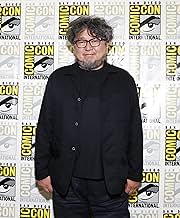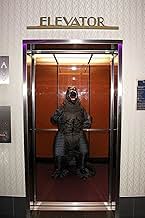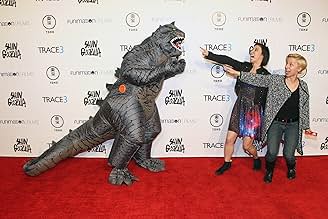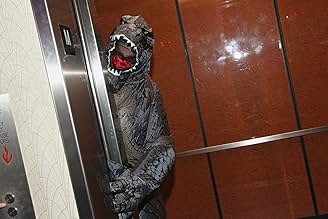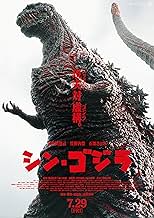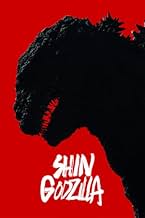Japan stürzt durch das Erscheinen eines riesigen Monsters in ein zerstörerisches Chaos.Japan stürzt durch das Erscheinen eines riesigen Monsters in ein zerstörerisches Chaos.Japan stürzt durch das Erscheinen eines riesigen Monsters in ein zerstörerisches Chaos.
- Regie
- Drehbuch
- Hauptbesetzung
- Auszeichnungen
- 13 Gewinne & 10 Nominierungen insgesamt
Empfohlene Bewertungen
After waiting for a whole year, I finally got my hands on the award-winning Japanese film "Shin Godzilla", directed by Hideaki Anno (Evangelion) and Shinji Higuchi (live action Attack On Titan). With the praise this film got, did it live up to the hype for me? Yes and to an extent no.
The film is a modern-day remake, showing how would the Japanese government (and to an extent other governments) react if Godzilla showed up for the first time today. This film is one of the more politically-charged entries in the franchise and is more of a thriller than a straight-up monster movie. There are lots of characters, a majority of which don't have much personality, but the main ones like protagonist Rando I found myself latching on to. Some the best scenes are when the characters stop acting like politicians and have casual and occasionally humorous dialogue. At least they took the whole situation very seriously with rarely an over-the-top moment much like the 2014 film, a breath of fresh air within the franchise. There's also this mystery element that plays a huge part in the story which I liked very much. Just as the 1954 film was a metaphor for Hiroshima and Nagasaki, this one reflects the Fukushima meltdown as well as the tsunami and earthquake Japan suffered a few years back (goes to show that Godzilla will always find a way to stay relevant).
How does Big G himself hold up? Pretty good. His design is more-or-less an update of his original 1954 look, his skin looking like radiation scars. New to the series is that Godzilla EVOLVES throughout, starting out smaller and very odd-looking but growing larger, more powerful, and even smarter as the story progresses, making him unpredictable. I also enjoyed the exploration of his biology, that is how this creature could exist. My complaints fall under a few things, strictly on his main form: his arms are too small and he isn't very expressive, mostly just lumbering along in a straight line. When he does gets mad, however, that's when he really shines. The action scenes are entertaining enough and there's plenty of destruction featured with some surprising moments here and there. The special effects are largely CGI with elements of practical effects, both of which are good; Big G isn't a man in a suit this time (kinda disappointing) but rather motion capture, though there are a few well-done miniatures. Some sound effects are of the old era and the music is a mix of the original's by Akira Ifukube with some new ones by Shiro Sagisu, a lovely combo. There's even a track from Evangelion (Decisive Battle).
My favorite scene: The first time Godzilla uses his atomic breath. Set at night with a mournful choir singing in the background (w/ English lyrics), the suspense that builds to the monster unleashing his power and rage upon the world was epic, chilling even, and has tremendous payoff. It's a truly apocalyptic image.
There are a few issues to address. I admit the pacing isn't the best. The beginning particularly has some rapid editing and there are texts on the screen throughout (often naming a character and political position) that are quite distracting and take getting used to, though I suppose you're supposed to feel as rushed as these politicians. Also, there's a huge gap before the climax where there's no action going on that I honestly think the filmmakers should have cut down a little. I like the characters and what's happening to them, but I would have preferred for the film to cut to the chase a bit.
Overall, this movie has its faults for sure, but I'm still glad I saw it. It was an interesting twist to my favorite fictional character. More films in both Japan and America are on the way and I can't wait. Long live the King of the Monsters!
The film is a modern-day remake, showing how would the Japanese government (and to an extent other governments) react if Godzilla showed up for the first time today. This film is one of the more politically-charged entries in the franchise and is more of a thriller than a straight-up monster movie. There are lots of characters, a majority of which don't have much personality, but the main ones like protagonist Rando I found myself latching on to. Some the best scenes are when the characters stop acting like politicians and have casual and occasionally humorous dialogue. At least they took the whole situation very seriously with rarely an over-the-top moment much like the 2014 film, a breath of fresh air within the franchise. There's also this mystery element that plays a huge part in the story which I liked very much. Just as the 1954 film was a metaphor for Hiroshima and Nagasaki, this one reflects the Fukushima meltdown as well as the tsunami and earthquake Japan suffered a few years back (goes to show that Godzilla will always find a way to stay relevant).
How does Big G himself hold up? Pretty good. His design is more-or-less an update of his original 1954 look, his skin looking like radiation scars. New to the series is that Godzilla EVOLVES throughout, starting out smaller and very odd-looking but growing larger, more powerful, and even smarter as the story progresses, making him unpredictable. I also enjoyed the exploration of his biology, that is how this creature could exist. My complaints fall under a few things, strictly on his main form: his arms are too small and he isn't very expressive, mostly just lumbering along in a straight line. When he does gets mad, however, that's when he really shines. The action scenes are entertaining enough and there's plenty of destruction featured with some surprising moments here and there. The special effects are largely CGI with elements of practical effects, both of which are good; Big G isn't a man in a suit this time (kinda disappointing) but rather motion capture, though there are a few well-done miniatures. Some sound effects are of the old era and the music is a mix of the original's by Akira Ifukube with some new ones by Shiro Sagisu, a lovely combo. There's even a track from Evangelion (Decisive Battle).
My favorite scene: The first time Godzilla uses his atomic breath. Set at night with a mournful choir singing in the background (w/ English lyrics), the suspense that builds to the monster unleashing his power and rage upon the world was epic, chilling even, and has tremendous payoff. It's a truly apocalyptic image.
There are a few issues to address. I admit the pacing isn't the best. The beginning particularly has some rapid editing and there are texts on the screen throughout (often naming a character and political position) that are quite distracting and take getting used to, though I suppose you're supposed to feel as rushed as these politicians. Also, there's a huge gap before the climax where there's no action going on that I honestly think the filmmakers should have cut down a little. I like the characters and what's happening to them, but I would have preferred for the film to cut to the chase a bit.
Overall, this movie has its faults for sure, but I'm still glad I saw it. It was an interesting twist to my favorite fictional character. More films in both Japan and America are on the way and I can't wait. Long live the King of the Monsters!
Japan is back in the game with their very own new Godzilla movie SHIN GOJIRA. Where Hollywood revived Godzilla as a tribute to his more heroic role in the late-showa era "versus" movies and the Heisei era, Toho Japan has gone back to the roots of the 1954 original Gojira and crafted a modern thriller about the horrors of mankind's misdeeds, the inaction of a government embroiled in bureaucracy and the impotence of a military in the face of this fiercer, meaner, force of nature Godzilla. .
SHIN GODZILLA is likely the first Godzilla movie to focus squarely on the political scene within the government when a giant monster attacks. Past movies have always involved Scientists, soldiers, or civilians focusing on the chaos on the ground. This movies looks into the chaos at the top as we follow young civil servant Yaguchi, deputy chief cabinet secretary (the first in a long list of designations to come).
A regular day in the government is interrupted by the collapse of the Tokyo bay aqua line tunnel and mysterious attacks off the coast of Japan. While the aged officials hold fruitless meeting after meeting in an obvious parody of real life bureaucratic process, Yaguchi theorists that the disasters are caused by a living creature.
No sooner is his theory shot down than an enormous tail rises out of the water. As the government scrambles but always falling a step behind the escalating disaster, Yaguchi forms a task force of unorthodox civilian experts to figure out how to stop this creature.
As the government's tried and tested efforts become increasingly futile, USA sends a special envoy Kayako Ann Patterson with the promise of military aid and insider knowledge to this mysterious creature dubbed "Godzilla".
The creature is growing, mutating, and taking on increasingly dangerous characteristics. Yaguchi's team is forced to think outside the box for a new way to halt its rampage before the UN deploys nuclear weapons on Japanese soil.
Contrary to the trailers, this is not the dark depressing disaster movie that was promised. Instead we are treated to one of the smartest and most biting social and political satires in modern cinema. Right in the crosshairs is the inefficient bureaucratic processes of the government and their obsession with trivial minutia which results in a complete mishandling of the crisis posed by the constantly evolving Godzilla.
The satire comes in the fact that the film does not overly dramatize anything; what you see is as close to reality as one can get in an old fashion parliamentary government like Japan's. Each ministry out for itself, passing the buck wherever possible, defending only their own interests. Standard procedures take precedence over unconventional methods.
Scenes of the prime minister making an announcement of Godzilla not being able to come ashore, intercut with the revelation that not only has the creature made landfall but has started trashing the town, hearkened back to the perceived mishandling of past real life disasters in Japan.
Yet the message underlying this movie is not a strict criticism of the government but an affirming call to action aimed at a new generation of leaders to unite a nation. Where the traditional methods fail, innovation and initiative will be the true weapons of the future. Yaguchi and his team represent this perfectly; outcasts from their respective fields because of their unconventional ideas.
Their tenacity in the face of hopeless defeat soon inspires fellow citizens from all walks of life, engineers, mechanics, construction workers and other blue collar roles typically overlooked by a status obsessed people, to come together and stand against a God incarnate.
The titular monster is unlike any incarnation ever seen. It's keloid looking skin, seemingly torn in places, gives the impression of pure suffering. Yet his inhuman all staring eyes betray a being devoid of soul. It is as it was back in 1954; a soulless unstoppable force birthed from mankind's sins. The military is powerless, though not for a lack of trying.
Where previous Godzilla movies have shown the military in a less than flattering light (cowardly, incompetent, or unable to hit such a massive creature), SHIN GODZILLA shows a military force truly giving their all, only hampered by slow indecision from the top.
The special effects used to bring this colossus to life is arguably good. No where near Hollywood blockbusters but amazing once you consider the comparatively tiny budget Toho had to work with. The naturalistic direction an camera-work courtesy of Evangelion creator Hideki Anno and his crew give the movie an almost "documentary" type feel.
It is devoid of filters, using very natural looking lighting wherever possible, which enhances the realism of the events taking place. Though the cuts can be a bit distracting at times, alternating between rapid fire jump cuts to scenes that look as if Anno left his camera running and forgot about it. Equally distracting is some of CGI compositing on Godzilla and some of his movements which end up more jerky than a puppet's. These are just minor faults though and only an issue to the more OCD of viewers.
Perhaps the only thing it does lack is the element of human drama. It is unafraid to show the horrible consequences of a monster's rampage through a macro view of a country's key decision makers but in doing so it does not leave opportunity to get the audience invested in any particular character.
More than just a monster movie, SHIN GODZILLA is a smart political thriller that satirizes an inflexible system. Those expecting a brainless action blockbuster will no doubt be disappointed. But as long as one is willing to turn in the brain and appreciate this movie for the deeper more complex themes it tries to tackle, you will find a refreshingly novel giant monster movie which the industry definitely needs.
SHIN GODZILLA is likely the first Godzilla movie to focus squarely on the political scene within the government when a giant monster attacks. Past movies have always involved Scientists, soldiers, or civilians focusing on the chaos on the ground. This movies looks into the chaos at the top as we follow young civil servant Yaguchi, deputy chief cabinet secretary (the first in a long list of designations to come).
A regular day in the government is interrupted by the collapse of the Tokyo bay aqua line tunnel and mysterious attacks off the coast of Japan. While the aged officials hold fruitless meeting after meeting in an obvious parody of real life bureaucratic process, Yaguchi theorists that the disasters are caused by a living creature.
No sooner is his theory shot down than an enormous tail rises out of the water. As the government scrambles but always falling a step behind the escalating disaster, Yaguchi forms a task force of unorthodox civilian experts to figure out how to stop this creature.
As the government's tried and tested efforts become increasingly futile, USA sends a special envoy Kayako Ann Patterson with the promise of military aid and insider knowledge to this mysterious creature dubbed "Godzilla".
The creature is growing, mutating, and taking on increasingly dangerous characteristics. Yaguchi's team is forced to think outside the box for a new way to halt its rampage before the UN deploys nuclear weapons on Japanese soil.
Contrary to the trailers, this is not the dark depressing disaster movie that was promised. Instead we are treated to one of the smartest and most biting social and political satires in modern cinema. Right in the crosshairs is the inefficient bureaucratic processes of the government and their obsession with trivial minutia which results in a complete mishandling of the crisis posed by the constantly evolving Godzilla.
The satire comes in the fact that the film does not overly dramatize anything; what you see is as close to reality as one can get in an old fashion parliamentary government like Japan's. Each ministry out for itself, passing the buck wherever possible, defending only their own interests. Standard procedures take precedence over unconventional methods.
Scenes of the prime minister making an announcement of Godzilla not being able to come ashore, intercut with the revelation that not only has the creature made landfall but has started trashing the town, hearkened back to the perceived mishandling of past real life disasters in Japan.
Yet the message underlying this movie is not a strict criticism of the government but an affirming call to action aimed at a new generation of leaders to unite a nation. Where the traditional methods fail, innovation and initiative will be the true weapons of the future. Yaguchi and his team represent this perfectly; outcasts from their respective fields because of their unconventional ideas.
Their tenacity in the face of hopeless defeat soon inspires fellow citizens from all walks of life, engineers, mechanics, construction workers and other blue collar roles typically overlooked by a status obsessed people, to come together and stand against a God incarnate.
The titular monster is unlike any incarnation ever seen. It's keloid looking skin, seemingly torn in places, gives the impression of pure suffering. Yet his inhuman all staring eyes betray a being devoid of soul. It is as it was back in 1954; a soulless unstoppable force birthed from mankind's sins. The military is powerless, though not for a lack of trying.
Where previous Godzilla movies have shown the military in a less than flattering light (cowardly, incompetent, or unable to hit such a massive creature), SHIN GODZILLA shows a military force truly giving their all, only hampered by slow indecision from the top.
The special effects used to bring this colossus to life is arguably good. No where near Hollywood blockbusters but amazing once you consider the comparatively tiny budget Toho had to work with. The naturalistic direction an camera-work courtesy of Evangelion creator Hideki Anno and his crew give the movie an almost "documentary" type feel.
It is devoid of filters, using very natural looking lighting wherever possible, which enhances the realism of the events taking place. Though the cuts can be a bit distracting at times, alternating between rapid fire jump cuts to scenes that look as if Anno left his camera running and forgot about it. Equally distracting is some of CGI compositing on Godzilla and some of his movements which end up more jerky than a puppet's. These are just minor faults though and only an issue to the more OCD of viewers.
Perhaps the only thing it does lack is the element of human drama. It is unafraid to show the horrible consequences of a monster's rampage through a macro view of a country's key decision makers but in doing so it does not leave opportunity to get the audience invested in any particular character.
More than just a monster movie, SHIN GODZILLA is a smart political thriller that satirizes an inflexible system. Those expecting a brainless action blockbuster will no doubt be disappointed. But as long as one is willing to turn in the brain and appreciate this movie for the deeper more complex themes it tries to tackle, you will find a refreshingly novel giant monster movie which the industry definitely needs.
'Shin Godzilla' isn't Toho's vainglorious attempt at re-capturing the success of recent Hollywood adaptations of its iconic Japanese monster. Quite the contrary, co-directors Hideaki Anno and Shinji Higuchi know better than try to outdo their Western counterparts in terms of spectacle, and instead have made the astute decision to make a distinctly Japanese 'Godzilla' that will most certainly resonate with their home audience, even at the expense of alienating some non-Japanese viewers without the same cultural or historical context. In fact, we dare say that their film has the unique distinction of being both political allegory as well as real-world horror, and is surprisingly effective on either count.
No other recent event has been so seared in the Japanese consciousness as that of the 2011 Tohoko earthquake and tsunami as well as the consequent Fukushima nuclear disaster, not just because of the hundreds of thousands of people affected but also because it exposed how terribly unprepared the Japanese government was with handling a crisis of such proportions. The parallels here are unmistakable – from an indecisive Prime Minister (Ren Ôsugi) to the frustratingly bureaucratic attitude of his Cabinet ministers to the embarrassing revelation of his poor judgment (such as during a live press conference where Godzilla makes landfall right after he specifically tells the people that the creature will not) – and indeed meant no less than a searing indictment of just how inept the Naoto Kan's administration was during 3/11.
Yet it isn't hard to imagine how a movie based solely on such criticism would quickly turn monotonous, not least because the lead characters here are all political/ Government figures – among them, Hiroki Hasegawa's outspoken and gutsy Deputy Chief of Cabinet Secretary Rando Yaguchi, Yutaka Takenouchi's opportunistic Aide to the Prime Minister Hideki Akasaka, and Satomi Ishihara's Special Envoy for the United States Kayoko Ann Patterson – and each is defined only in terms of his or her role and ambition in relation to the ongoing calamity. None too subtle is the point, emphatically and unequivocally made, that while politicians wield the ingenuity and authority it takes to manage an unprecedented catastrophe, each is also simultaneously weighting the cost or opportunity of every decision or maneuver to his or her political futures.
Just as illuminating, especially to the Japanese, is the strengths or limits of its military might post-WWII, seeing as how it has never yet seen the need to invoke the use of its Self-Defense Forces (SDF) or call in the help of the US military under the US-Japan Security Treaty. Under the pretense of exterminating Godzilla, Anno's screenplay imagines what it would take not just for the SDF to be activated but also how US intervention would likely come with some strings attached. How and if at all it is meant to play into the current Shinzo Abe's push for an expansion of the SDF role is quite perceptively left up to the audience's interpretation, but there is no doubting that the introduction of the United Nations late into the film is meant to demonstrate how powerless nations not on its Security Council may be to resolutions passed by its five members on non-member countries.
Yes, if it isn't yet clear, there is no intent here to highlight the human dimension of such an event; rather, it is domestic politics as well as the global world order that forms the basis of this re- incarnation of Godzilla. As a reboot, 'Shin Godzilla' starts on a clean slate, beginning with an underwater disturbance that briefly makes its way onto shore before going back out to sea, then returning as a much more highly evolved organism that grows and grows ever more fearsome. Fans though will not be disappointed – as with past iterations of Godzilla, this latest version not only has the ability to radiate highly destructive atomic rays from its dorsal fins, it also can set streets of buildings ablaze by spewing fire out of its mouth. It does take time to get used to the new 'ShinGoji' design, but rest assured that this beast is every bit as terrifying as it should be.
In fact, that palpable sense of fear is twofold – first, in tying the origins of Godzilla to Japan's ignominious nuclear history; and second, in showing with utmost realism the wanton destruction of notable landmarks in Tokyo by the monster. The former has to do as much with the United States' alleged dumping of radioactive waste in Tokyo Bay in the 1950s and 1960s as accusations of Japan's own disposal of toxic ash from the burning of Fukushima's nuclear waste into the same waters. The latter, on the other hand, sees entire districts in Tokyo ripped or flattened by Godzilla's rampage, impressively staged by co-director cum VFX supervisor Anno (also known for last summer's 'Attack of Titan') using a mix of old- fashioned puppetry and modern CGI. In particular, the combined US- Japan military assault on Godzilla along the banks of the Kano River and the finale in downtown Shinjuku is stunning, especially in imagining the magnitude of destruction that Godzilla could inflict on modern-day Japan.
Yet if the promotional materials have given the impression that 'Shin Godzilla' is an action-packed blockbuster like its most recent Hollywood predecessors, you'll do best to temper those expectations. Sure, there are beautiful sequences of Godzilla wreaking havoc, but because the focus is on displaying different types of political personalities and their responses towards such a crisis of proportions, there is a lot of talking (as well as 'talking heads') throughout the film and especially in the beginning. By tapping into the paranoia, fear and frustration of their fellow Japanese following their own recent real-life crises, Anno and Higuchi have made a contemporary 'Godzilla' that is sure to roar loud with their home crowd – and by that count, this is as its Japanese title suggests, a new and true incarnation as relevant as it is frightening.
No other recent event has been so seared in the Japanese consciousness as that of the 2011 Tohoko earthquake and tsunami as well as the consequent Fukushima nuclear disaster, not just because of the hundreds of thousands of people affected but also because it exposed how terribly unprepared the Japanese government was with handling a crisis of such proportions. The parallels here are unmistakable – from an indecisive Prime Minister (Ren Ôsugi) to the frustratingly bureaucratic attitude of his Cabinet ministers to the embarrassing revelation of his poor judgment (such as during a live press conference where Godzilla makes landfall right after he specifically tells the people that the creature will not) – and indeed meant no less than a searing indictment of just how inept the Naoto Kan's administration was during 3/11.
Yet it isn't hard to imagine how a movie based solely on such criticism would quickly turn monotonous, not least because the lead characters here are all political/ Government figures – among them, Hiroki Hasegawa's outspoken and gutsy Deputy Chief of Cabinet Secretary Rando Yaguchi, Yutaka Takenouchi's opportunistic Aide to the Prime Minister Hideki Akasaka, and Satomi Ishihara's Special Envoy for the United States Kayoko Ann Patterson – and each is defined only in terms of his or her role and ambition in relation to the ongoing calamity. None too subtle is the point, emphatically and unequivocally made, that while politicians wield the ingenuity and authority it takes to manage an unprecedented catastrophe, each is also simultaneously weighting the cost or opportunity of every decision or maneuver to his or her political futures.
Just as illuminating, especially to the Japanese, is the strengths or limits of its military might post-WWII, seeing as how it has never yet seen the need to invoke the use of its Self-Defense Forces (SDF) or call in the help of the US military under the US-Japan Security Treaty. Under the pretense of exterminating Godzilla, Anno's screenplay imagines what it would take not just for the SDF to be activated but also how US intervention would likely come with some strings attached. How and if at all it is meant to play into the current Shinzo Abe's push for an expansion of the SDF role is quite perceptively left up to the audience's interpretation, but there is no doubting that the introduction of the United Nations late into the film is meant to demonstrate how powerless nations not on its Security Council may be to resolutions passed by its five members on non-member countries.
Yes, if it isn't yet clear, there is no intent here to highlight the human dimension of such an event; rather, it is domestic politics as well as the global world order that forms the basis of this re- incarnation of Godzilla. As a reboot, 'Shin Godzilla' starts on a clean slate, beginning with an underwater disturbance that briefly makes its way onto shore before going back out to sea, then returning as a much more highly evolved organism that grows and grows ever more fearsome. Fans though will not be disappointed – as with past iterations of Godzilla, this latest version not only has the ability to radiate highly destructive atomic rays from its dorsal fins, it also can set streets of buildings ablaze by spewing fire out of its mouth. It does take time to get used to the new 'ShinGoji' design, but rest assured that this beast is every bit as terrifying as it should be.
In fact, that palpable sense of fear is twofold – first, in tying the origins of Godzilla to Japan's ignominious nuclear history; and second, in showing with utmost realism the wanton destruction of notable landmarks in Tokyo by the monster. The former has to do as much with the United States' alleged dumping of radioactive waste in Tokyo Bay in the 1950s and 1960s as accusations of Japan's own disposal of toxic ash from the burning of Fukushima's nuclear waste into the same waters. The latter, on the other hand, sees entire districts in Tokyo ripped or flattened by Godzilla's rampage, impressively staged by co-director cum VFX supervisor Anno (also known for last summer's 'Attack of Titan') using a mix of old- fashioned puppetry and modern CGI. In particular, the combined US- Japan military assault on Godzilla along the banks of the Kano River and the finale in downtown Shinjuku is stunning, especially in imagining the magnitude of destruction that Godzilla could inflict on modern-day Japan.
Yet if the promotional materials have given the impression that 'Shin Godzilla' is an action-packed blockbuster like its most recent Hollywood predecessors, you'll do best to temper those expectations. Sure, there are beautiful sequences of Godzilla wreaking havoc, but because the focus is on displaying different types of political personalities and their responses towards such a crisis of proportions, there is a lot of talking (as well as 'talking heads') throughout the film and especially in the beginning. By tapping into the paranoia, fear and frustration of their fellow Japanese following their own recent real-life crises, Anno and Higuchi have made a contemporary 'Godzilla' that is sure to roar loud with their home crowd – and by that count, this is as its Japanese title suggests, a new and true incarnation as relevant as it is frightening.
This is an excellent show that differs from the standard hack-and- slash and action-driven natures of other recent films (Independence Day 2 etc.). It is one of the most narrative-driven films that I've watched in the last 2 years.
PROS:
CONS
CONCLUSION:
PROS:
- The acting was great as a whole, comprising of much seriousness and focus, typical of the exigency of a nation-wide disaster, in the top politicians of the diet.
- It is full of political irony, satire of the Japanese government's and bureaucracy's indecision and red-taping. There is great intelligence imbued into movie, and it shows that much research has been done prior to filming. It also shows the way in which foreign and indigenous affairs have been interwoven together in governmental decision-making. I greatly appreciate this as a whole, as the narration is full of meaning and subtlety.
- The special effects of Godzilla were absolutely wonderful, portraying both scale and grandeur in Godzilla's size and style. I greatly enjoyed the four main scenes where Godzilla made its appearance, especially its climax at the latter two.
- The pacing was fast-paced, and little time was wasted. A lot of content had been packaged into a duration of just 120 minutes. While watching, I thought that the film lasted for 4 hours, as there were so many occurrences!
- The style and pace also remains true to the original Godzilla classics. So is the provenance of Godzilla.
CONS
- Ishihara would not have fooled us into thinking that she is a Japanese-American English speaker!
- Overall, it is very dialogue-heavy. This is both a strength and weakness. A strength as there is much character development, but also excessive to the point that it sometimes can be dreary and draggy. This is the greatest setback of the film, and could have been further streamlined. Minus 1 star for this.
CONCLUSION:
- As a whole, I rate it 9 out of 10, and will watch it again.
- Most people who have an appreciation for subtlety and nuance, and also of vivid storytelling will like this film.
- However, those who prefer a CGI roller-coaster like Independence Day 2 or 2012 may be turned off by the extremely heavy dialogue.
First of all, if you are expecting the stereotypical monster movie where the point of it is just watching a monster destroy stuff and watch people running around, you WILL be disappointed. The majority of this film takes place in offices and meeting rooms.
Japan just went through a nation-wide Earthquake that took more than 15,000 lives, and triggered the second worst nuclear meltdown in history, both just five years ago. And this is a clear satire on the sociopolitical events since.
The film takes us through what goes on in the government when a unprecedented crisis hits the nation. It's a bunch of long meetings, finger-pointing, paperwork, and slow decision-making. It is the epitome of dysfunctional bureaucracy.
On top of all that, you start to see the US government and other UN nations start to poke their heads into the matter, treating the hometown of 15 million Japanese people like just another battleground for just another war.
There are no clear-cut heroes; Just a group of normal people who are experts in their own fields, doing their best to contribute and put this disaster to an end. They have to fight the politics more than the actual monster.
The reality of all of this is astonishing, and completely believable. It starts to feel like a crisis simulation film.
But of course, the center of it all is Godzilla:
Godzilla himself is truly awe-inspiring in this film. What they have done with the monster is totally new, different from any of the Godzillas in the past (be careful of spoilers out there on the web if you want to experience the amazement). It's personally my favorite by far. Throughout the film, Godzilla is dubbed as "The truly perfect organism", "The most evolved being on the planet", and "A god". So that is the level which you should expect. His crazy power is far beyond belief, so you can safely immerse yourself into this fictional monster.
The tag-line for "Godzilla Resurgence" in Japan reads: "Reality(Japan) V.S. Fiction(Godzilla)". So you are witnessing the fault line between reality and fiction.
When Godzilla is turning the city of Tokyo into rubble, the Japanese don't see fiction. They see the events of 2011/03/11. The director clearly took measures to parallel the tsunamis, the rubble, and the fear of radiation to the events in real life.
Put that together with the bureaucratic mess, the international politics, and terror/awesomeness of the devastating monster Godzilla; The result is this masterpiece. It's a movie clearly wouldn't have come out from the Hollywood scene.
It does have it's faults (like Satomi Ishihara's cartoonish character), but the impact and significance of the film far surpasses its faults.
A must-watch.
Japan just went through a nation-wide Earthquake that took more than 15,000 lives, and triggered the second worst nuclear meltdown in history, both just five years ago. And this is a clear satire on the sociopolitical events since.
The film takes us through what goes on in the government when a unprecedented crisis hits the nation. It's a bunch of long meetings, finger-pointing, paperwork, and slow decision-making. It is the epitome of dysfunctional bureaucracy.
On top of all that, you start to see the US government and other UN nations start to poke their heads into the matter, treating the hometown of 15 million Japanese people like just another battleground for just another war.
There are no clear-cut heroes; Just a group of normal people who are experts in their own fields, doing their best to contribute and put this disaster to an end. They have to fight the politics more than the actual monster.
The reality of all of this is astonishing, and completely believable. It starts to feel like a crisis simulation film.
But of course, the center of it all is Godzilla:
Godzilla himself is truly awe-inspiring in this film. What they have done with the monster is totally new, different from any of the Godzillas in the past (be careful of spoilers out there on the web if you want to experience the amazement). It's personally my favorite by far. Throughout the film, Godzilla is dubbed as "The truly perfect organism", "The most evolved being on the planet", and "A god". So that is the level which you should expect. His crazy power is far beyond belief, so you can safely immerse yourself into this fictional monster.
The tag-line for "Godzilla Resurgence" in Japan reads: "Reality(Japan) V.S. Fiction(Godzilla)". So you are witnessing the fault line between reality and fiction.
When Godzilla is turning the city of Tokyo into rubble, the Japanese don't see fiction. They see the events of 2011/03/11. The director clearly took measures to parallel the tsunamis, the rubble, and the fear of radiation to the events in real life.
Put that together with the bureaucratic mess, the international politics, and terror/awesomeness of the devastating monster Godzilla; The result is this masterpiece. It's a movie clearly wouldn't have come out from the Hollywood scene.
It does have it's faults (like Satomi Ishihara's cartoonish character), but the impact and significance of the film far surpasses its faults.
A must-watch.
Wusstest du schon
- WissenswertesThe film has a rare 3.1 sound mix.
- PatzerThe drug that the government uses to kill Godzilla is described as something that will "disable his internal cooling system". After the drug is used at the end, Godzilla freezes. If the drug was supposed to disable his internal cooling system, it would have overheated him, not frozen him. But it's a bit more complex than that... In fact, in the movie the drug actually does manage to disable Godzilla's cooling system, but in stead of overheating him this triggers a SCRAM-shutdown (=Safety Control Rods Activation Mechanism) as a kind of involuntarily overreaction-thus freezing him in the procedure. By freezing himself temporarily, Godzilla is able to survive this potentially critical trauma.
- Zitate
Hiromi Ogashira, Deputy Director of Nature Conservation Bureau: Man is more frightening than Gojira.
- Crazy CreditsThe Toho logo appears as the 1950s color version to homage Godzilla - Das Original (1954)'s era.
Godzilla's stomping and roar is heard, which also happened in Godzilla - Das Original (1954).
- SoundtracksPersecution of the Masses
Written by Shirô Sagisu
Lyrics by Mike Wyzgowski
Soprano vocals performed by Catherine Bott
Alto and Mezzo-Soprano vocals performed by Deborah Miles-Johnson
Tenor vocals performed by Andrew Busher
Bass vocals performed by Michael George
Orchestra by London Studio Orchestra
Top-Auswahl
Melde dich zum Bewerten an und greife auf die Watchlist für personalisierte Empfehlungen zu.
Details
- Erscheinungsdatum
- Herkunftsland
- Offizielle Standorte
- Sprachen
- Auch bekannt als
- Godzilla Resurge
- Drehorte
- Produktionsfirmen
- Weitere beteiligte Unternehmen bei IMDbPro anzeigen
Box Office
- Bruttoertrag in den USA und Kanada
- 1.918.403 $
- Eröffnungswochenende in den USA und in Kanada
- 458.342 $
- 16. Okt. 2016
- Weltweiter Bruttoertrag
- 78.053.145 $
- Laufzeit2 Stunden
- Farbe
- Seitenverhältnis
- 2.39 : 1
Zu dieser Seite beitragen
Bearbeitung vorschlagen oder fehlenden Inhalt hinzufügen







